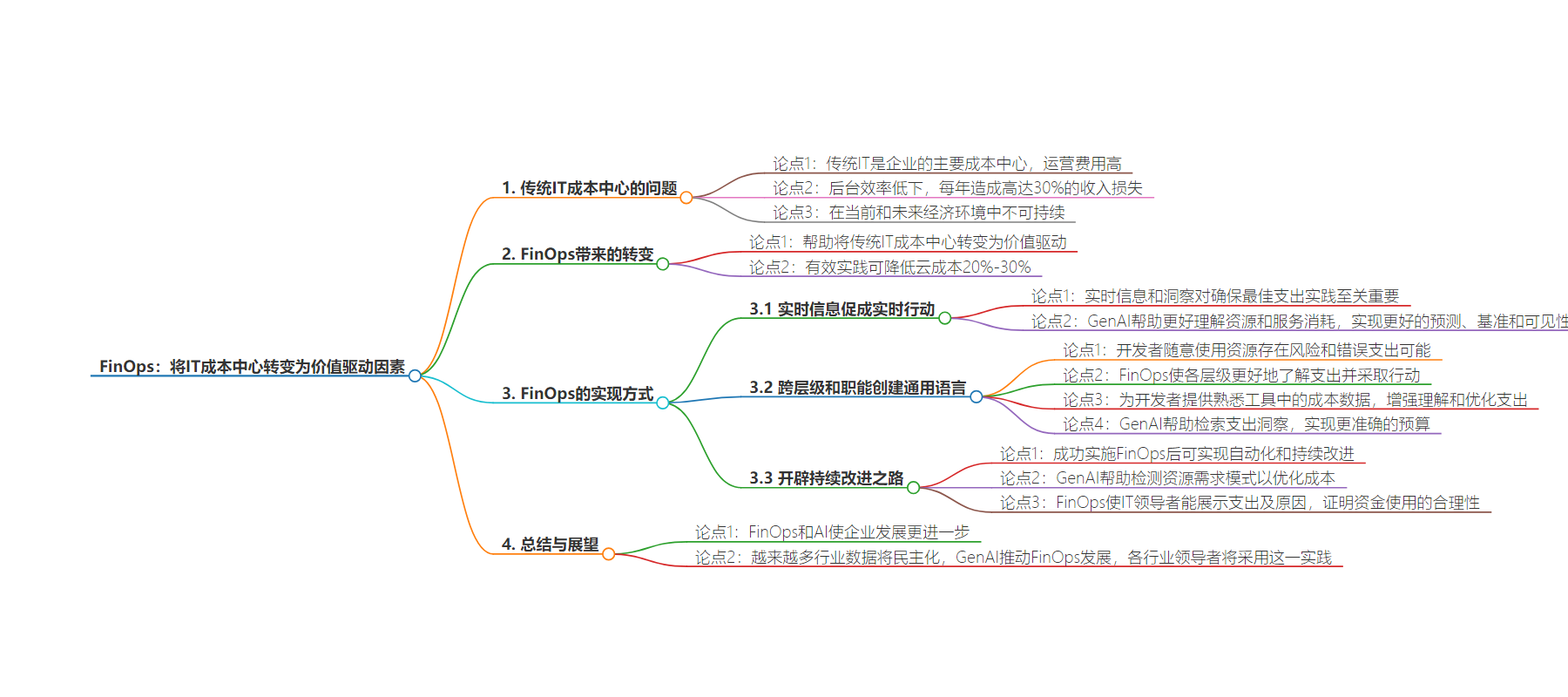包阅导读总结
1. 关键词:FinOps、IT 成本中心、价值驱动、云计算、持续改进
2. 总结:传统上 IT 是主要成本中心,FinOps 作为云运营模式和最佳实践能将其转变为价值驱动因素,通过实时信息、创建共同语言和持续改进实现,GenAI 也起到辅助作用,未来更多企业将采用。
3. 主要内容:
– FinOps 能将传统 IT 成本中心转变为关键价值驱动因素
– 研究表明有效 FinOps 实践可降低云成本 20%-30%
– 借助实时信息采取行动
– 实时信息和洞察能确保最佳支出实践,GenAI 帮助理解资源消耗
– 利用 AI 实现更好的预测、分析和规划
– 创建跨层级和职能的共同语言
– 任何人都需更好了解支出,FinOps 提供透明度和共同理解
– 开发者能通过熟悉工具了解成本数据,GenAI 帮助获取洞察
– 开辟持续改进之路
– 成功实施后可自动化并建立持续改进文化
– GenAI 助力检测模式,IT 领导者能展示支出及效果
思维导图:
文章地址:https://thenewstack.io/finops-can-turn-it-cost-centers-into-a-value-driver/
文章来源:thenewstack.io
作者:Bill Lobig
发布时间:2024/8/1 15:52
语言:英文
总字数:869字
预计阅读时间:4分钟
评分:83分
标签:FinOps,云经济,成本优化,IT 管理,持续改进
以下为原文内容
本内容来源于用户推荐转载,旨在分享知识与观点,如有侵权请联系删除 联系邮箱 media@ilingban.com
The reality is that IT has traditionally been a major cost center within the business. Rather than contributing to profits, it often results in high operational expenses. Back-office inefficiencies, like those within IT, cost companies up to 30% of revenue every year. In today’s economy or any economy, this model is not sustainable, particularly as companies strive to increase tech investments over the next year and beyond.
However, there is good news. FinOps, the operating model for the cloud and a set of best practices can help companies shift their traditional IT “cost center” to a critical value driver with novel transparency. How do we know this? Recent research shows effective FinOps practices can reduce cloud costs by as much as 20%-30%, transforming IT operations from a burden into a significant business asset.
As cloud practitioners better utilize FinOps, leveraging the variable economics of cloud and generative AI to drive collaboration, inform decision-making, and create value, operations can reach new heights. Here’s how.
Real-Time Information = Real-Time Action
If a manufacturing CFO cannot access spending data, how can informed financial decisions on product and supply chain be made? The same applies to those managing cloud usage budgets. Appropriate action and real-time changes can only be made to ensure best spending practices with real-time information and insights into spend. This can lead to several problems, from reputation loss to decreased (or stalled) productivity and severe financial instability. Deterring these problems, FinOps supplies the crucial intel to make data-driven, cost-effective decisions around holistic cloud usage in real time.
Further, GenAI bolsters this approach by giving leaders a better understanding of how applications consume resources and services so costs can be more effectively tagged and analyzed. This enables better forecasting, better benchmarking, and increased visibility. You can’t manage what you can’t see. Practitioners can better understand spending trajectories and anomalies by using these insights and conversational experiences powered by AI customer experience chatbots. Predictive analysis makes time spent scrolling through Excel sheets and multiple dashboards a pastime. Now, we’re equipped to prepare for “what-if” scenarios, and we can shift our focus to strategic planning.
A Common Language Is Created Across Levels and Functions
Today, any developer can log into their account, use resources, and spend money on any given day of the week. This seems very easy and accessible. However, programs can be left running, or the wrong type of resources can be deployed. Unfortunately, this leaves room for an immense risk of error and can accentuate unnecessary spending.
With this risk, it’s clear that anyone from CIOs to finance to developers needs better visibility into expenditures and the ability to act on these insights. This is where the power of FinOps comes in, as it enables leaders to delegate IT budgets with complete visibility. This transparency allows insight into how funds are being allocated. Breaking down barriers between teams and deploying a common language throughout the enterprise enables a cohesive understanding that cannot be achieved any other way.
Developers are also empowered by surfacing cost data into tools they are familiar with and use frequently, such as observability platforms. This enhances understanding and optimizes spending and goals. GenAI also helps retrieve insights into spend by using natural language to ask questions while detecting patterns and trends (especially when the spending is out of line with expectations). It also enables unprecedented granularity and accuracy when meeting budget KPIs. This ultimately creates more confidence when building a budget. As a result, forecasting becomes more accurate and reliable, and workload planning is more straightforward, creating a language accessible and understood by all.
FinOps Forges a Path of Continuous Improvement
Once FinOps has been successfully implemented within an organization, teams can begin to automate the practice while building a culture of continuous improvement. Leaders can now better forecast and plan, leading to more precise budgeting. Additionally, GenAI can provide unique insights into seasonality. For example, if a resource demand spikes every three days at other unpredictable frequencies, AI can help you detect these patterns so you can optimize by scaling up when required and back down to save costs during lulls in demand. This kind of pattern detection is difficult without AI.
It all goes back to the concept of understanding value and total cost. With FinOps, IT leaders can demonstrate exactly what they spend on and why. They can point out how the budget for software licenses and labor is directly tied to IT operations outcomes, translating into greater resiliency and higher customer satisfaction. They can prove that they’ve spent money responsibly and that they should retain that level of funding because it makes the business run better.
FinOps and AI advancements allow businesses to do more and go further than they ever could. Almost 65% of CFOs are integrating AI into their strategy. As we look forward, more and more cost and utilization data across industries will be democratized. GenAI is the strategic lever that catapults this practice into the future, and it’s only a matter of time before all leaders take hold of this practice across sectors and industries.
YOUTUBE.COM/THENEWSTACK
Tech moves fast, don’t miss an episode. Subscribe to our YouTubechannel to stream all our podcasts, interviews, demos, and more.
